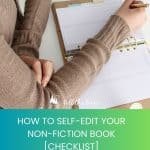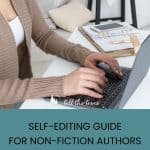by Michelle
Share
by Michelle
Share

It’s important to use self-editing whenever you write a book.
When you finish writing a first draft, you will continue rewriting, editing, and proofing your work. Sometimes you’ll include outside help especially the closer you get to the final draft. During the initial writing process, you can self-edit and use the checklist below to help you. Note that some items in the checklist would more useful before you hand it over to an editor, while some sections work best for when you are self-editing at the beginning of your project.

Self-Editing for Purpose and Scope:
- Ensure that the purpose and main argument of the book are clear and well-defined.
- Verify that the content aligns with the intended scope and stays focused on the central topic.
- Confirm that the book effectively communicates its message to the target audience.
Structure and Organization:
- Ensure that the chapters are well-organized and follow a logical progression.
- Check that each chapter has a clear focus and contributes to the overall purpose of the book.
- Verify that transitions between chapters are smooth and coherent.
- Confirm that the introduction and conclusion effectively frame the book’s content.
Information Accuracy and Credibility:
- Ensure that all facts, figures, and statements are accurate and up-to-date.
- Verify that sources are reliable, credible, and properly cited.
- Check for any potential biases or inconsistencies in the presented information.
- Confirm that the author’s expertise and authority on the subject are evident.
Self-Editing for Clarity and Readability:
- Ensure that the writing is clear, concise, and easy to understand for the target audience.
- Check for jargon or technical terms that may need explanation or simplification.
- Verify that the language and tone are appropriate for the subject matter and reader.
- Confirm that the writing style is engaging and maintains reader interest.
Examples and Evidence:
- Ensure that examples, case studies, and anecdotes effectively illustrate key points.
- Check that the evidence presented adequately supports the arguments and claims made.
- Verify that the examples are relevant, diverse, and representative of the topic.
Visuals and Formatting:
- Ensure that charts, graphs, images, and other visuals are clear, accurate, and properly labeled.
- Check that visuals enhance the reader’s understanding and complement the text.
- Verify that the formatting, including headings, subheadings, and lists, is consistent and easy to navigate.
- Confirm that the overall layout and design are professional and visually appealing.
Self-Editing for Grammar, Punctuation, and Style:
- Run a spell check and grammar check to catch any errors.
- Verify that punctuation is used correctly and consistently.
- Ensure that the writing adheres to the chosen style guide (e.g., APA, Chicago, MLA) for formatting and citations.
- Check for consistent use of abbreviations, acronyms, and capitalization. (Note: Check the Resources for tools!)
Practicality and Actionability:
- Ensure that the book provides practical insights, tips, or actionable advice for readers.
- Verify that the recommendations and strategies presented are feasible and well-explained.
- Check that the book anticipates and addresses potential questions or concerns from readers.
Consistency and Coherence:
- Ensure that the writing is consistent in terms of voice, tone, and style throughout the book.
- Check for any contradictions or inconsistencies in the information or arguments presented.
- Verify that all chapters and sections work together cohesively to support the central theme or purpose.
Overall Impact and Value:
- Consider the overall value and impact the book provides to its target audience.
- Ensure that the book delivers on its promised benefits and meets reader expectations.
- Verify that the book leaves readers with a clear understanding of the subject matter and practical takeaways.
- Confirm that the book contributes something unique or valuable to its field or genre.
- Consider adding freebies or downloads to the back of the book for further education and reach.
Disclaimer: The self-editing checklists in this document were initially generated with the assistance of Claude, an AI language model developed by Anthropic. However, the content has been thoroughly reviewed, edited, and adapted by the author to ensure its accuracy, relevance, and usefulness for the intended audience. While AI tools can provide helpful suggestions and insights, the final content is the result of human expertise and judgment. The use of AI on posts on this website will always include a disclaimer.
Tell the Trees is supported by its readers. When you make a purchase using links on this site, it may result in affiliate commission. Please visit my affiliate disclosure page for more information.
Let's Discuss It
The EU Accessibility Act officially kicked in on June 28, 2025, and that means it's being enforced right now. Here's what to expect for self-publishing.
Sometimes what we call perfectionism is just fear of rejection in disguise. We keep our work hidden because putting it out there means people can judge it.
Ever wonder why some books take off with book sales while others collect digital dust? When it comes to book marketing, I’ve noticed the same problems pop up again and again. Let me walk you through a real example that perfectly illustrates what NOT to do—and more importantly, how to fix it. The Post &
D2D for print books will not replace Amazon KDP for most authors—the royalty difference is just too significant if you're primarily selling direct to consumers online. But it's not supposed to replace Amazon; it's supposed to complement it.










